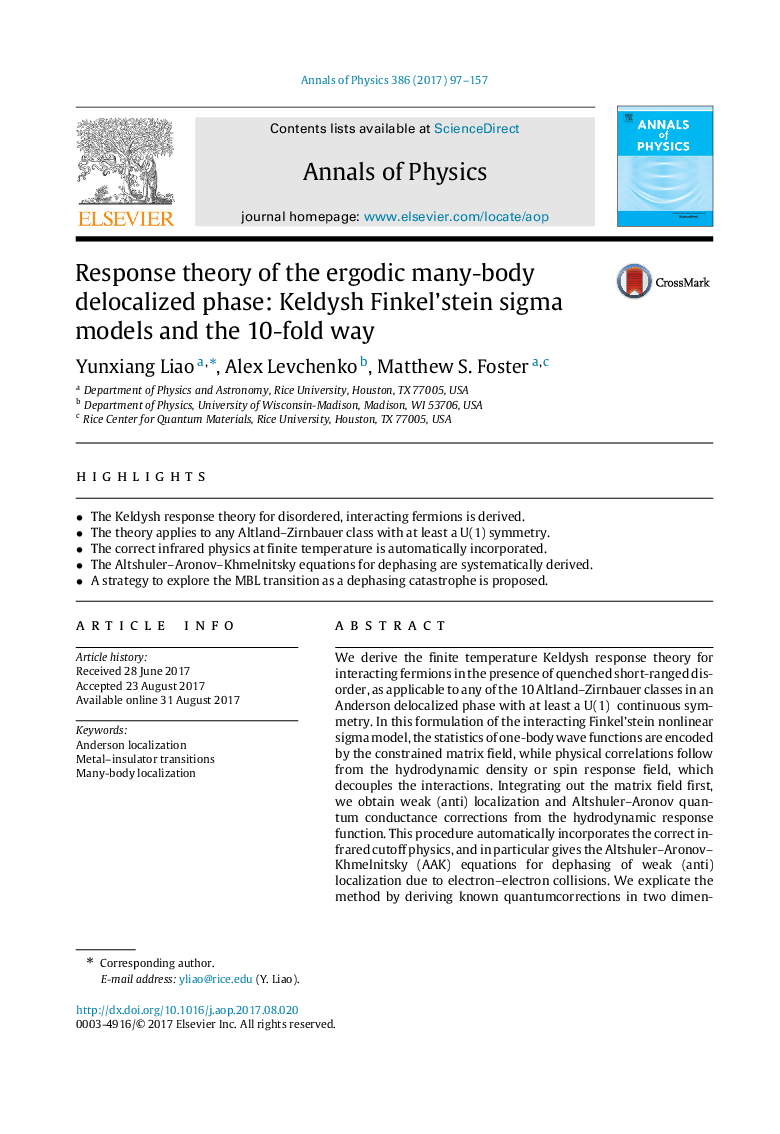| کد مقاله | کد نشریه | سال انتشار | مقاله انگلیسی | نسخه تمام متن |
|---|---|---|---|---|
| 5495733 | 1529825 | 2017 | 61 صفحه PDF | دانلود رایگان |
عنوان انگلیسی مقاله ISI
Response theory of the ergodic many-body delocalized phase: Keldysh Finkel'stein sigma models and the 10-fold way
دانلود مقاله + سفارش ترجمه
دانلود مقاله ISI انگلیسی
رایگان برای ایرانیان
کلمات کلیدی
موضوعات مرتبط
مهندسی و علوم پایه
فیزیک و نجوم
فیزیک و نجوم (عمومی)
پیش نمایش صفحه اول مقاله

چکیده انگلیسی
We derive the finite temperature Keldysh response theory for interacting fermions in the presence of quenched short-ranged disorder, as applicable to any of the 10 Altland-Zirnbauer classes in an Anderson delocalized phase with at least a U(1) continuous symmetry. In this formulation of the interacting Finkel'stein nonlinear sigma model, the statistics of one-body wave functions are encoded by the constrained matrix field, while physical correlations follow from the hydrodynamic density or spin response field, which decouples the interactions. Integrating out the matrix field first, we obtain weak (anti) localization and Altshuler-Aronov quantum conductance corrections from the hydrodynamic response function. This procedure automatically incorporates the correct infrared cutoff physics, and in particular gives the Altshuler-Aronov-Khmelnitsky (AAK) equations for dephasing of weak (anti)localization due to electron-electron collisions. We explicate the method by deriving known quantumcorrections in two dimensions for the symplectic metal class AII, as well as the spin-SU(2) invariant superconductor classes C and CI. We show that quantum conductance corrections due to the special modes at zero energy in nonstandard classes are automatically cut off by temperature, as previously expected, while the Wigner-Dyson class Cooperon modes that persist to all energies are cut by dephasing. We also show that for short-ranged interactions, the standard self-consistent solution for the dephasing rate is equivalent to a particular summation of diagrams via the self-consistent Born approximation. This should be compared to the corresponding AAK solution for long-ranged Coulomb interactions, which exploits the Markovian noise correlations induced by thermal fluctuations of the electromagnetic field. We discuss prospects for exploring the many-body localization transition as a dephasing catastrophe in short-range interacting models, as encountered by approaching from the ergodic side.
ناشر
Database: Elsevier - ScienceDirect (ساینس دایرکت)
Journal: Annals of Physics - Volume 386, November 2017, Pages 97-157
Journal: Annals of Physics - Volume 386, November 2017, Pages 97-157
نویسندگان
Yunxiang Liao, Alex Levchenko, Matthew S. Foster,